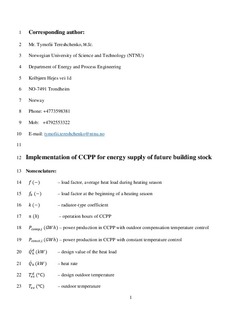| dc.contributor.author | Tereshchenko, Tymofii | |
| dc.contributor.author | Nord, Natasa | |
| dc.date.accessioned | 2019-01-21T12:31:34Z | |
| dc.date.available | 2019-01-21T12:31:34Z | |
| dc.date.created | 2015-09-15T13:08:55Z | |
| dc.date.issued | 2015 | |
| dc.identifier.citation | Applied Energy. 2015, 155 753-765. | nb_NO |
| dc.identifier.issn | 0306-2619 | |
| dc.identifier.uri | http://hdl.handle.net/11250/2581529 | |
| dc.description.abstract | European Directive 2010/31/EU stated that by the end of 2020 all new buildings should be nearly Zero-Energy Buildings (nZEB). Since such buildings require a low quantity of energy for heating, they can utilize energy from the return line of a District Heating (DH) system. Further, this new type of buildings can successfully be integrated into the fourth generation of heat distribution technology, which is the new trend in the DH industry. On the other hand, existing building stock has a service lifetime of around 50 years, indicating that the required supply temperature in the DH system cannot be lowered beneath a certain level. Hereafter, together with new types of buildings and different policies, this could lead to changes in heat demand profiles of the DH system.
The above-mentioned situation in the building market will lead to changes in heat load profiles and unavoidably influence the performance indicators of energy conversion units. Therefore, the focus in this paper was devoted to operation analysis of ethanol-based a Combined Heat and Power (CHP) plant with combined cycle technology under changeable demand conditions and different temperature levels in the DH system.
In this paper different temperature levels of the DH system together with two temperature control strategies were considered. Further, the analysis included different heat demand profiles. The analysis was performed in Aspen HYSYS simulation software and data post processing was made by MATLAB. The results found that effective plant operation is highly dependent on heat load profile. Temperature control strategies did not induce a significant change in overall power production in CHP. The decrease in the supply temperature did not show a significant impact on plant performance. However, increase in temperature difference between supply and return lines led to higher power production and better overall plant performance. Further, it was concluded that it is rather difficult to operate CCPP connected to low energy building stock. This means that the CCPP is suitable for high-density heat areas, while it has poor energy performance indicators in low heat density areas. | nb_NO |
| dc.language.iso | eng | nb_NO |
| dc.publisher | Elsevier | nb_NO |
| dc.rights | Attribution-NonCommercial-NoDerivatives 4.0 Internasjonal | * |
| dc.rights.uri | http://creativecommons.org/licenses/by-nc-nd/4.0/deed.no | * |
| dc.title | Implementation of CCPP for energy supply of future building stock | nb_NO |
| dc.type | Journal article | nb_NO |
| dc.type | Peer reviewed | nb_NO |
| dc.description.version | acceptedVersion | nb_NO |
| dc.source.pagenumber | 753-765 | nb_NO |
| dc.source.volume | 155 | nb_NO |
| dc.source.journal | Applied Energy | nb_NO |
| dc.identifier.doi | 10.1016/j.apenergy.2015.06.021 | |
| dc.identifier.cristin | 1264334 | |
| dc.description.localcode | © 2015. This is the authors’ accepted and refereed manuscript to the article. This manuscript version is made available under the CC-BY-NC-ND 4.0 license http://creativecommons.org/licenses/by-nc-nd/4.0/ | nb_NO |
| cristin.unitcode | 194,64,25,0 | |
| cristin.unitname | Institutt for energi- og prosessteknikk | |
| cristin.ispublished | true | |
| cristin.fulltext | postprint | |
| cristin.qualitycode | 1 | |

